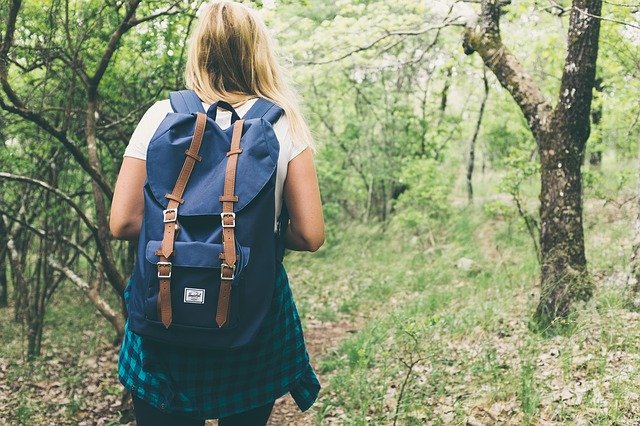If you are going on a walk, be prepared for any eventuality. The important thing is not to have everything with you, but to have what you need for the ride!
Always take water with you: hunger is much better fought than thirst
First of all, you are not sure you will find any where you are going to. Secondly, when you walk, you have to drink. This helps to hydrate muscles and tendons. You will avoid cramps, aches and strains by drinking regularly. Moreover you may have underestimated the heat, the wind, the effort. A risk of dehydration is never to be taken lightly.
A whistle and a compass are essential accessories that can save you from a bad situation when hanging on to your backpack
The compass will allow you to find your way back if you have previously located your position. The whistle may save you because if you have a problem, you may be immobilised and will not be able to go for help. To call for help, it’s perfect!
Three short, three long, three short (in Morse code it means SOS) at regular intervals will alert the other hikers who, out of solidarity, will try to help you.
Wear brightly coloured clothing
You will be easier to find if you have a problem. You can use your fluo green anorak or pink fleece to signal you. In the mountains as well as in the countryside and everywhere else, it is extremely difficult to be spotted by the rescue services.
Accessories that you should always carry with you when you go for a walk
I have heard so many times “it’s just a ride for the day“, “it’s not far“, “it’s a leisurely stroll” or worse, “it’s OK, we’re used to it“, that even if I have to take your contempt in the face, I prefer to summarise the essentials of the trip:
- A lighter to make fire
- A headlamp if you allow yourself to be surprised by the darkness.
- Toilet paper for intestinal emergencies
- A Swiss Army knife or at least an Opinel knife.
- Energy bars against hypoglycaemia or hunger
- A first aid kit in the event of an accident (plaster, disinfectant in a mini wipe, a bandage for a sprain or deep cut, sterile compresses, tiger balm…). No need to bring the complete kit, just the necessary items will suffice.
- Sun cream
- An insect repellent
- A hat
All this does not take up much space and will allow you to deal with the most important things.
Beware of the weather, in Asia, the rain is not the same as in Europe
You have to rely on the fact that you do not know the country and its bad weather. In the mountains, as soon as the sun goes down, the temperature drops at a crazy speed. One hour late on the route and you will find yourself walking in shorts in 6-8° C temperatures, whereas it was scorching hot when you left. Ask the locals for their sound advice and, above all, follow it!
Are you used to it? Yes, in Europe but not in America or Asia
You have to have walked through the suffocating jungle to realise that you don’t spend the same energy at all in an environment with 40° to 100% humidity as in the Alps! The efforts are not the same. The terrain is different. The weather, the sun, insects, everything changes! You may find yourself having to cross a river of mud that wasn’t there on the way, see your eye take the shape of an egg following a bug bite. When travelling, be far-sighted! And if nothing happens to you, so much the better, but you will be able to help those who have left less well equipped than you!
Count large!
Take a margin on the recommended return time. Fatigue, sprains, delays due to misorientation can take on worrying proportions if you have to return at night.
Don’t count on electronics to save you
Smartphones are great tools, but they need energy to work. They can break, oxidize, break down and most importantly, fail to pick up a network or be unable to locate you on the GPS!
Count on yourself but tell someone about your ride
Locate your positions, check your compass regularly, take a map…and tell someone about your departure and estimated time of return. They will be able to give an alert if you are still not back by midnight.
Dress accordingly for the walk
These tips may seem superfluous, but if you want to avoid traumatic experiences that will immobilise you for 3 days or force you to wear flip-flops for the rest of the trip, think again! I’ve seen some amazing things. Spaniards attempting the Annapurna circuit in flip-flops, bloody heels, multiple blisters and hikers in light trainers in the jungle. Put on your shoes and dress appropriately. French mountain rescuers are always complaining about it: they have to assist unconscious tourists trying to hike on glaciers in shorts and without glasses! Wear slid and practical clothing.
Don’t run, walk slow and take your time
The Nepalese porters have told me over and over again: accidents happen when you hurry! Walk slowly, don’t take unnecessary risks. You don’t turn for Jackass.
Just be ready and enjoy the ride!
Don’t leave with fear in your stomach. Treks, walks, it’s great. Get information and advice from those who know: the locals!
Don’t be arrogant, you already have experience, but you are facing an unknown context. Are you ready? Then have a good walk!
